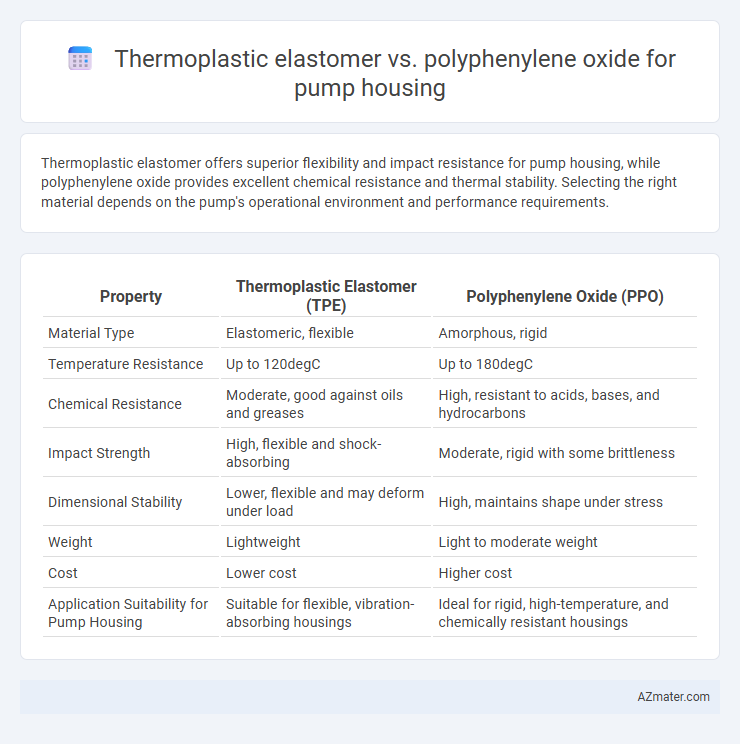Thermoplastic elastomer offers superior flexibility and impact resistance for pump housing, while polyphenylene oxide provides excellent chemical resistance and thermal stability. Selecting the right material depends on the pump's operational environment and performance requirements.
Table of Comparison
| Property | Thermoplastic Elastomer (TPE) | Polyphenylene Oxide (PPO) |
|---|---|---|
| Material Type | Elastomeric, flexible | Amorphous, rigid |
| Temperature Resistance | Up to 120degC | Up to 180degC |
| Chemical Resistance | Moderate, good against oils and greases | High, resistant to acids, bases, and hydrocarbons |
| Impact Strength | High, flexible and shock-absorbing | Moderate, rigid with some brittleness |
| Dimensional Stability | Lower, flexible and may deform under load | High, maintains shape under stress |
| Weight | Lightweight | Light to moderate weight |
| Cost | Lower cost | Higher cost |
| Application Suitability for Pump Housing | Suitable for flexible, vibration-absorbing housings | Ideal for rigid, high-temperature, and chemically resistant housings |
Introduction to Thermoplastic Elastomer and Polyphenylene Oxide
Thermoplastic elastomers (TPE) are versatile polymers that combine the elasticity of rubber with the processing ease of thermoplastics, making them ideal for pump housings requiring flexibility and impact resistance. Polyphenylene oxide (PPO) offers exceptional thermal stability, chemical resistance, and dimensional stability, suitable for pump housings exposed to harsh environments and high temperatures. Comparing TPE and PPO highlights the trade-offs in flexibility versus rigidity and temperature endurance critical for pump housing performance.
Material Properties Comparison: TPE vs PPO
Thermoplastic elastomers (TPE) offer excellent flexibility, impact resistance, and vibration damping, making them ideal for pump housings requiring elasticity and shock absorption. Polyphenylene oxide (PPO) provides superior thermal stability, chemical resistance, and dimensional stability, suitable for applications demanding high heat tolerance and corrosive fluid exposure. While TPE excels in flexibility and noise reduction, PPO outperforms in mechanical strength and long-term durability under harsh environmental conditions.
Chemical Resistance in Pump Housing Applications
Thermoplastic elastomers (TPEs) exhibit excellent chemical resistance to a broad spectrum of acids, bases, and oils, making them suitable for pump housings exposed to aggressive fluids. Polyphenylene oxide (PPO) offers superior resistance to hydrocarbons, oxidizing agents, and solvents, maintaining dimensional stability under chemical exposure. In pump housing applications, PPO's hydrolysis resistance and thermal stability often surpass TPEs, providing longer service life in harsh chemical environments.
Mechanical Strength and Durability Analysis
Thermoplastic elastomers (TPEs) offer excellent flexibility and impact resistance, making them suitable for pump housings requiring moderate mechanical strength and dynamic durability. Polyphenylene oxide (PPO) demonstrates superior stiffness, dimensional stability, and high thermal resistance, providing enhanced mechanical strength and long-term durability in demanding pump housing applications. Comparative analysis shows PPO outperforms TPE in resisting deformation under load and maintaining structural integrity during prolonged exposure to high temperatures and chemical environments.
Thermal Stability: Performance Under Varying Temperatures
Thermoplastic elastomers (TPE) exhibit moderate thermal stability, maintaining flexibility and impact resistance within temperatures typically ranging from -40degC to 120degC, making them suitable for pump housings operating under moderate thermal conditions. Polyphenylene oxide (PPO), however, offers superior thermal stability with continuous use temperatures up to 150degC and excellent dimensional stability, ensuring reliable performance in higher temperature environments. Selecting PPO for pump housings enhances durability and resistance to thermal deformation when exposed to elevated or fluctuating temperatures compared to TPE.
Processability and Manufacturing Considerations
Thermoplastic elastomers (TPEs) offer superior processability for pump housing applications due to their flexibility and ease of injection molding, enabling rapid cycle times and reduced tooling wear. In contrast, polyphenylene oxide (PPO) provides excellent dimensional stability and chemical resistance but requires higher processing temperatures and more precise control during molding to prevent degradation. Manufacturing considerations favor TPEs for complex geometries and cost-effective production, while PPO demands specialized equipment and stringent thermal management to maintain material integrity.
Cost Analysis: TPE vs PPO for Pump Housing
Thermoplastic elastomers (TPE) generally offer a lower initial material cost compared to polyphenylene oxide (PPO), making TPE a cost-effective choice for pump housing production, especially in high-volume manufacturing. PPO delivers superior thermal stability and chemical resistance, which can reduce maintenance and replacement costs over the pump's lifespan despite its higher upfront expense. Evaluating total cost of ownership favors TPE in budget-sensitive applications, while PPO suits environments demanding enhanced durability and performance.
Environmental Impact and Recyclability
Thermoplastic elastomers (TPE) offer superior recyclability due to their ability to be remolded and reused, resulting in reduced environmental impact for pump housing applications. Polyphenylene oxide (PPO), while providing excellent thermal stability and chemical resistance, poses challenges in recycling due to its complex aromatic structure, often leading to limited reuse options and increased landfill waste. Selecting TPE over PPO enhances sustainability by minimizing plastic waste and supporting circular economy initiatives in pump manufacturing.
Industry Applications and Case Studies
Thermoplastic elastomers (TPE) are widely used in pump housing applications within the automotive, chemical processing, and water management industries due to their excellent flexibility, chemical resistance, and ease of molding, ensuring durable and lightweight components. Polyphenylene oxide (PPO), valued for its high heat resistance, dimensional stability, and electrical insulation properties, is preferred in industrial equipment and electronic pump housings requiring long-term thermal and mechanical performance. Case studies highlight TPE's effectiveness in automotive fuel pumps for vibration damping, while PPO-based housings excel in chemical dosing pumps exposed to aggressive fluids and elevated temperatures.
Conclusion: Choosing the Right Material for Pump Housing
Thermoplastic elastomers offer superior flexibility, chemical resistance, and impact absorption, making them ideal for dynamic pump housing applications requiring vibration damping and thermal cycling tolerance. Polyphenylene oxide provides exceptional dimensional stability, high heat resistance up to 180degC, and excellent electrical insulating properties, suitable for pumps operating under high thermal stress and requiring structural rigidity. Selecting the right material depends on operational demands: choose thermoplastic elastomers for flexibility and chemical exposure, while polyphenylene oxide excels in high-temperature, rigid, and electrically insulating pump housings.

Infographic: Thermoplastic elastomer vs Polyphenylene oxide for Pump housing
 azmater.com
azmater.com